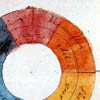

Les couleurs sont des actes de la lumière, ses actes et ses souffrances. Ainsi considéré, on peut attendre d’eux une explication de la lumière elle-même
DESCRIPTION
The cptcat utility concatenates GMT colour
palette table (cpt) files. The mandatory path
argument(s) specify the input files which may be specified in any order. However, when sorted,
the maximum (z-value) of the lower file should equal the minimum of the upper file; files can
be modified with the makecpt (1) utility to be in this
form.
The background colour will be taken from that of the lower (or lowest) file, and the forground from that of the upper.
The program will write to stdout if the -o option is not
specified.
OPTIONS
--backtrace-filepath-
Specify a file to which to write a formatted backtrace. The file will only be created if there is a backtrace created, typically when an error occurs.
--backtrace-formatformat-
Specify the
formatof the backtrace written to the files specified by--backtrace-file, one ofplain,xmlorjson. -h,--help-
Brief help.
-H,--hinge-hard-
Adds a
HARD_HINGEto the ouput, see HINGES below. -S,--hinge-soft-
Adds a
SOFT_HINGEto the ouput, see HINGES below. -o,--outputpath-
Write the output to
path, rather thanstdout. -v,--verbose-
Verbose operation.
-V,--version-
Version information.
-z,--z-normalise-
Normalise the z-values in the cpt output into the range 0/1 (or to -1/1 if a hinge is present) and add a
RANGEdirective if not present in the input. This is the form used in GMT master files.This option requires that output cpt version is at least 5.
-Z,--z-denormalise-
Set the z-values in the cpt output into the range given by the
RANGEdirective, and remove that directive. If there is noRANGEthen this option does nothing. -4,--gmt4-
Use GMT 4 conventions when writing the cpt output: the colour-model code is uppercase, and the colours are separated by spaces.
This is incompatible with the
-5and-6options of course.At present this option is the default, but that will change at some point. So specify this option if your use of the output depends on the GMT 4 layout (consumed by a custom parser, for example).
-5,--gmt5-
Use GMT 5 conventions when writing the cpt output: the colour-model code is lowercase, and the colours are separated by a solidus for RGB, CMYK, by a dash for HSV.
This is incompatible with the
-4and-6options of course. -6,--gmt6-
As the
-5option, but allows theHARD_HINGEandSOFT_HINGEdirectives in place of the explicitHINGE =directive.This is incompatible with the
-4and-5options of course.
HINGES
The treatment of hinges in this program is rather different to that of the other programs reading and writing the cpt format, those retain the hinge (if any) found in the input.
However, an expected use-case for this program is to combine bathymetry and topography schemes, which would typically not have hinges, producing a bathymetry-topography scheme, which typically would.
Hence any hinges in the input will be ignored (a warning will be issued in this case), and
the output will have a hinge only if one of the --hinge-hard
(-H) or --hinge-soft (-S) options are given. These are a recent GMT feature, so the --gmt6 option is required.